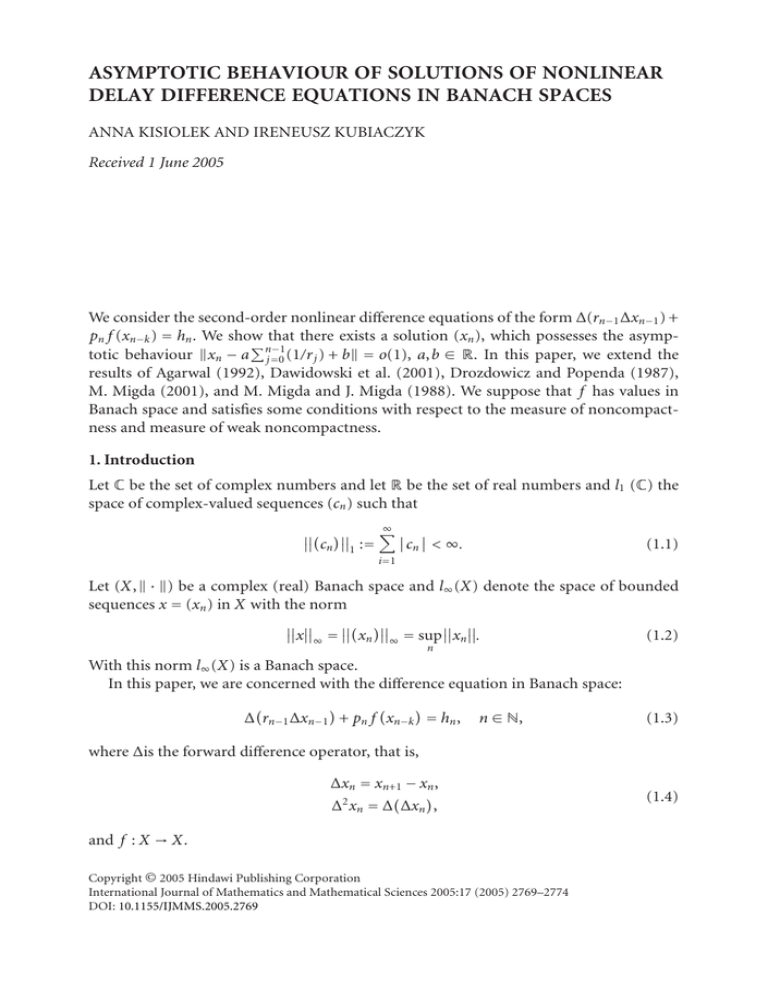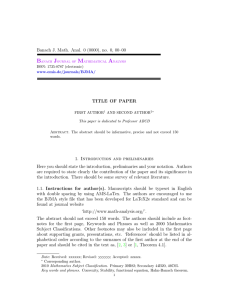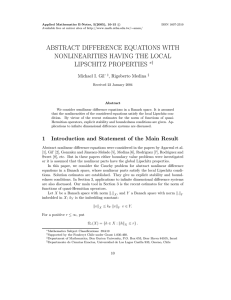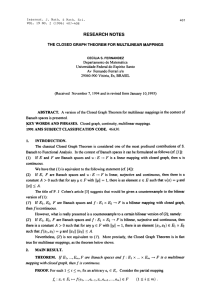ASYMPTOTIC BEHAVIOUR OF SOLUTIONS OF NONLINEAR
advertisement

ASYMPTOTIC BEHAVIOUR OF SOLUTIONS OF NONLINEAR
DELAY DIFFERENCE EQUATIONS IN BANACH SPACES
ANNA KISIOLEK AND IRENEUSZ KUBIACZYK
Received 1 June 2005
We consider the second-order nonlinear difference equations of the form ∆(rn−1 ∆xn−1 ) +
pn f (xn−k ) = hn . We show that there exists a solution (xn ), which possesses the asymp
totic behaviour xn − a nj =−01 (1/r j ) + b = o(1), a,b ∈ R. In this paper, we extend the
results of Agarwal (1992), Dawidowski et al. (2001), Drozdowicz and Popenda (1987),
M. Migda (2001), and M. Migda and J. Migda (1988). We suppose that f has values in
Banach space and satisfies some conditions with respect to the measure of noncompactness and measure of weak noncompactness.
1. Introduction
Let C be the set of complex numbers and let R be the set of real numbers and l1 (C) the
space of complex-valued sequences (cn ) such that
∞
cn := cn < ∞.
1
(1.1)
i=1
Let (X, · ) be a complex (real) Banach space and l∞ (X) denote the space of bounded
sequences x = (xn ) in X with the norm
x = xn = sup xn .
∞
∞
n
(1.2)
With this norm l∞ (X) is a Banach space.
In this paper, we are concerned with the difference equation in Banach space:
∆ rn−1 ∆xn−1 + pn f xn−k = hn ,
n ∈ N,
(1.3)
where ∆is the forward difference operator, that is,
∆xn = xn+1 − xn ,
∆2 xn = ∆ ∆xn ,
and f : X → X.
Copyright © 2005 Hindawi Publishing Corporation
International Journal of Mathematics and Mathematical Sciences 2005:17 (2005) 2769–2774
DOI: 10.1155/IJMMS.2005.2769
(1.4)
2770
Nonlinear delay difference equations in Banach spaces
By a solution of (1.3) we understand a sequence x = (xn ) in l∞ (X) which satisfies (1.3).
The results obtained here generalize some results of M. Migda and J. Migda [9, 10]. In
[10] the second-order difference equation of the form
∆2 xn = an ϕ xn+k ,
n = 1,2,..., k = 0,1,2,...,
(1.5)
was considered. Authors give a condition when this equation has a solution, asymptotically equal to c, c ∈ R.
2. Main results
We give necessary and sufficient conditions for the existence of solutions.
Let f be the function from X to X, (pn ), (rn ) sequences of real numbers, and (hn )
a sequence in Banach space.
Let D be a nonempty, closed, convex, and bounded subset of Banach space.
Our result will be proved by the following fixed point theorem.
Theorem 2.1 [5]. Let D be a nonempty, closed, convex, and bounded subset of Banach
space.
Let F : D → D be a continuous mapping, which is condensing with respect to the measure
of noncompactness α:
α F(V ) ≤ Lα(V ),
L < 1.
(2.1)
Then F has fixed point, where α is the Kuratowski’s measure of noncompactness.
Theorem 2.2. Let V ⊂ C(N + ,X) be a family of functions. Then
α(V ) = α V N +
= sup α(V (i)) : i ∈ N + ,
(2.2)
where α(V ) denotes the measure of noncompactness in C(N + ,X).
A theorem similar to Theorem 2.1 was proved by Arino et al. [2], see also [8, 11],
w
w
→ x0 , then f (xn ) −
→ f (x0 )
when f is weakly-weakly sequentially continuous, that is, if xn −
for each sequence (xn ), and instead of α we used β-weak measure of noncompactness.
Theorem 2.3. Let f : X → X be the bounded and continuous function.
Let
t=
∞
n =1
n−1 1 p n < ∞,
r
j =0 j
n −1 ∞
1 h n < ∞ .
(2.3)
r
j =0 j
n =1
Moreover,
α f (V ) ≤ kα(V ),
where kt < 1.
(2.4)
A. Kisiolek and I. Kubiaczyk
2771
Then for every a,b ∈ R there exists a solution (xn ) of (1.3) which possesses the asymptotic
behaviour
n
−1
1
x n − a
= o(1).
+
b
rj
(2.5)
j =0
Proof. Let a,b ∈ X. There exists a constant M > 1 such that f (t) < M for each t ∈ X.
Assume that
kn = pn + hn ln =
1
rn
∞
j =n+1
for n ∈ N,
(2.6)
kj.
From (2.3) we have
∞
n =1
n −1 n −1 ∞
1 1 pn +
h n r
j =0 j
=
∞
n =1
n −1 1 n =1
r
j =0 j
r
j =0 j
p n + h n =
∞
n −1 1
n =1
r
j =0 j
kn
1
1 1
1 1 1
+ k2 ·
+
+ k3 ·
+ +
+ ···
r0
r0 r1
r0 r1 r2
1
1
1
=
k1 + k2 + k3 + · · · +
k2 + k3 + · · · +
k3 + · · ·
r0
r1
r2
= k1 ·
=
∞
∞
1 r
n=1 n−1 j =n
kj =
∞
n =1
(2.7)
l n −1 .
So the series ∞
n=1 ln is convergent.
Let zn = ∞
j =n l j for n ∈ N.
Define the operator T : D → K, where
D = y = y1 , y2 , y3 ,... , yn ≤ Mzn ,
K = y = y1 , y2 , y3 ,... , y − a
n
n
−1
1
+b
r
j =0 j
n ∈ N,
≤ Mzn ,
n ∈ N.
(2.8)
For x ∈ D and n ∈ N we have
n −1
1
a
+ b,
j =0 r j
(Tx)n = n−1
∞
∞
1
1
+
b
−
pi f xi−k − hi ,
a
r
r
j =0 j
j =n j i= j+1
n ≤ m,
(2.9)
n > m.
2772
Nonlinear delay difference equations in Banach spaces
For n > m we have
n −1
1
(Tx)n − a
+
b
rj
j =0
n −1
∞
∞
n
−1
1
1 1
+
b
−
p
f
x
− b
= a
i
i
−k − h i − a
rj
rj
rj
j =0
j =n
i= j+1
j =0
∞
∞
1 pi f xi−k − hi =
rj
j =n
(2.10)
i= j+1
≤
∞
∞
∞
∞
1 1 pi f xi−k − hi ≤
pi f xi−k + hi ≤
∞
∞
∞
∞
∞
1 1 h i + M p i ≤
Mki ≤ M l j = Mzn .
r
j =n j i= j+1
r
j =n j i= j+1
r
j =n j i= j+1
r
j =n j i= j+1
j =n
So the operator T : D → K and the continuity of f , T is continuous.
Now, we will prove that T satisfies condition (2.1) of Theorem 2.1.
Let V ⊂ D, where V = {v : v = (v1 ,v2 ,...)} and T(V ) = {T(v) : v ∈ V }.
Let Vk = {vk : v ∈ V , v = (v1 ,v2 ,...,vk ,...)}. For n ≤ m we obtain
α T(V ) = α a
n
−1
1
+ b = 0.
r
j =0 j
(2.11)
For n > m we have
α T(V ) = sup α a
n
−1
n
∞
∞
1
1 +b−
p i f Vn − h i
r
r
j =0 j
j =n j i= j+1
n
−1
∞
∞
1
1 + b + α
pi f Vn − hi
≤ sup α a
r
r
n
j =0 j
j =n j i= j+1
n
−1
∞
∞
1
1 + b + sup α
p i f Vn − h i
≤ sup α a
r
r
n
n
j =0 j
j =n j i= j+1
≤ sup α
∞
∞
1
n
≤ sup α
∞
∞
1
n
≤ sup
n
r
j =n j i= j+1
r
j =n j i= j+1
∞
∞
1 r
j =n j i= j+1
p i f Vn +
∞
∞
1 r
j =n j i= j+1
hi
∞
∞
1
pi f Vn + sup α
hi
n
α p i f Vn ≤
r
j =n j i= j+1
∞
∞
1 pi α f (V ) .
r
j =n j i= j+1
(2.12)
A. Kisiolek and I. Kubiaczyk
2773
Using the inequality
α f (V ) ≤ kα(V ),
(2.13)
we obtain that
α T(V ) ≤ kα(V )
∞
∞
1 pi ≤ kα(V ).
r
j =n j i= j+1
(2.14)
By Theorem 2.1 T has a fixed point, and by the definition of T the solution x = (xn )
satisfies the condition
n
−1
1
x n − a
+ b
= o(1).
rj
(2.15)
j =0
This completes the proof of the theorem.
Because we can extend Theorem 2.1 as in [2, 8], so similar as Theorem 2.3 we can
prove the following theorem.
Theorem 2.4. Let f : X → X be the bounded and weakly-weakly continuous function.
Let
t=
∞ n
−1
1
p n < ∞,
r
n =1 j =0 j
∞ n
−1
1
h n < ∞ ,
(2.16)
r
n=1 j =0 j
and kt < 1.
Moreover
β f (V ) ≤ kβ(V ).
(2.17)
Then for every a,b ∈ R there exists a solution (xn ) of (1.3) which possesses the asymptotic
behaviour
n
−1
1
x n − a
= o(1).
+
b
rj
(2.18)
j =0
Remark 2.5. Observe that the class of continuous functions is different than the class of
weakly-weakly sequentially continuous functions and weakly-weakly continuous functions.
There exist many important examples of mappings which are weakly sequentially continuous but not weakly continuous.
The relationship between strong weak and weak sequential continuity for mappings is
studied in [3].
2774
Nonlinear delay difference equations in Banach spaces
References
[1]
[2]
[3]
[4]
[5]
[6]
[7]
[8]
[9]
[10]
[11]
R. P. Agarwal, Difference Equations and Inequalities. Theory, Methods, and Applications, Monographs and Textbooks in Pure and Applied Mathematics, vol. 155, Marcel Dekker, New
York, 1992.
O. Arino, S. Gautier, and J.-P. Penot, A fixed point theorem for sequentially continuous mappings
with application to ordinary differential equations, Funkcial. Ekvac. 27 (1984), no. 3, 273–
279.
J. M. Ball, Weak continuity properties of mappings and semigroups, Proc. Roy. Soc. Edinburgh
Sect. A 72 (1975), no. 4, 275–280.
J. Banaś and K. Goebel, Measures of Noncompactness in Banach Spaces, Lecture Notes in Pure
and Applied Mathematics, vol. 60, Marcel Dekker, New York, 1980.
G. Darbo, Punti uniti in trasformazioni a codominio non compatto, Rend. Sem. Mat. Univ.
Padova 24 (1955), 84–92 (Italian).
M. Dawidowski, I. Kubiaczyk, and J. Morchało, A discrete boundary value problem in Banach
spaces, Glas. Mat. Ser. III 36(56) (2001), no. 2, 233–239.
A. Drozdowicz and J. Popenda, Asymptotic behavior of the solutions of the second order difference
equation, Proc. Amer. Math. Soc. 99 (1987), no. 1, 135–140.
I. Kubiaczyk, On a fixed point theorem for weakly sequentially continuous mappings, Discuss.
Math. Differential Incl. 15 (1995), no. 1, 15–20.
M. Migda, Asymptotic behaviour of solutions of nonlinear delay difference equations, Fasc. Math.
(2001), no. 31, 57–62.
M. Migda and J. Migda, Asymptotic properties of the solutions of the second order difference equation, Arch. Math. (Brno) 34 (1998), no. 4, 467–476.
A. R. Mitchell and C. Smith, An existence theorem for weak solutions of differential equations
in Banach spaces, Nonlinear Equations in Abstract Spaces (Proc. Internat. Sympos., Univ.
Texas, Arlington, Tex., 1977) (V. Lakshmikantham, ed.), Academic Press, New York, 1978,
pp. 387–403.
Anna Kisiolek: Institute of Mathematics, Poznan University of Technology, 5 Maria SklodowskaCurie Square, 60-965 Poznan, Poland
E-mail address: akisiolek@fabryka.net.pl
Ireneusz Kubiaczyk: Collegium Mathematicum, Adam Mickiewicz University, Umultowska 87, 61614 Poznan, Poland
E-mail address: kuba@amu.edu.pl





